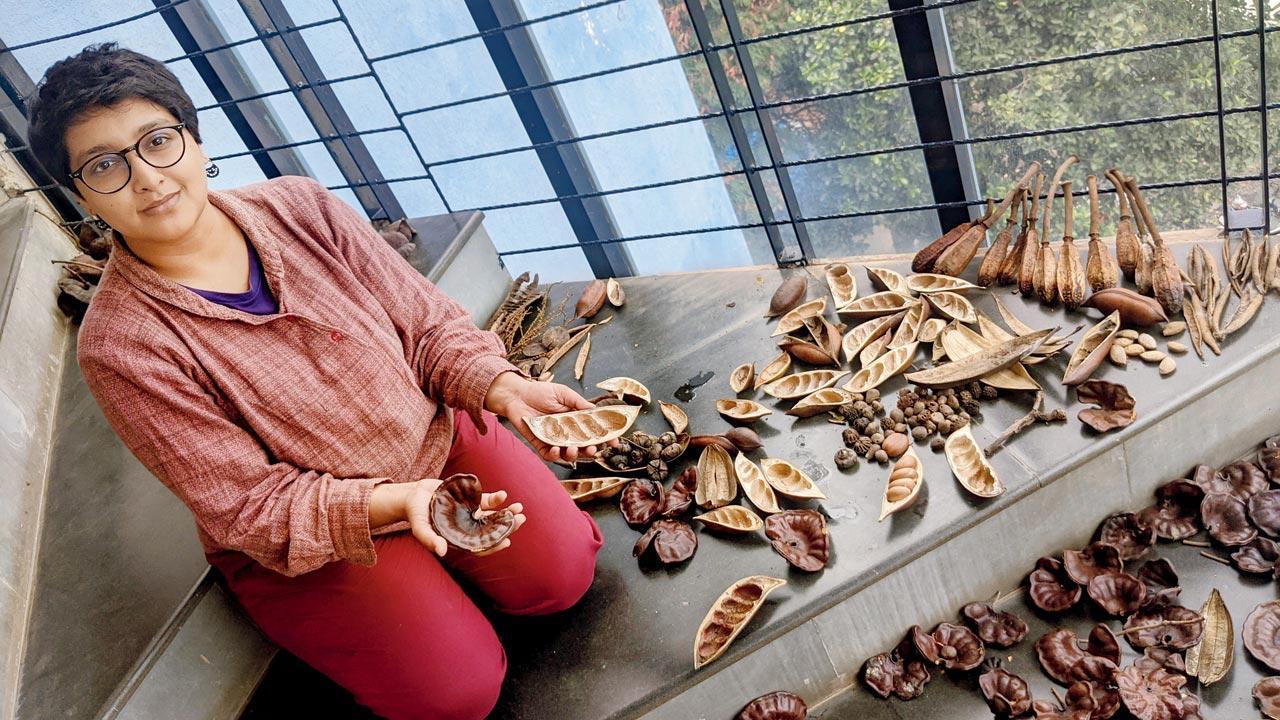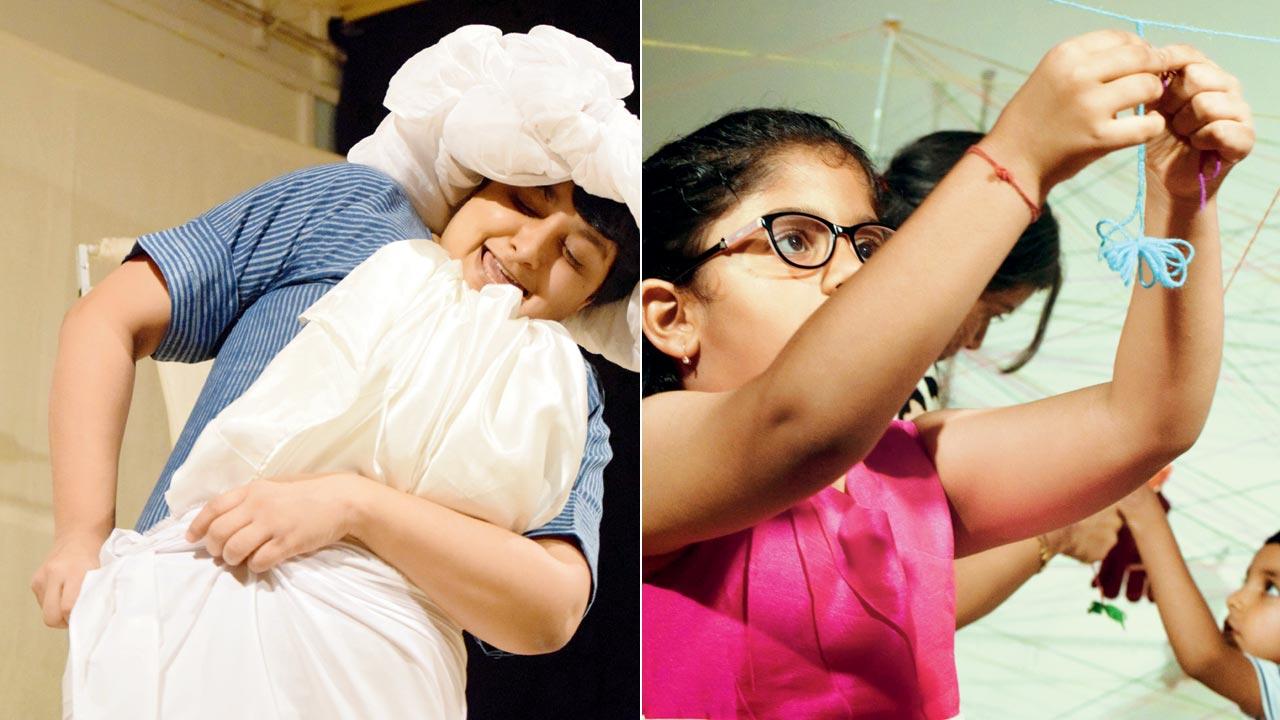In her fifth play targeted at toddlers, a theatre educator uses movement, material and non-verbal cues to evoke the microscopic environments that live off a tree

Sananda Mukhopadhyaya’s childhood in tree-laden Trombay was the perfect induction into the outdoors, influencing her work as an artiste
![]() A Mumbaikar is currently exploring tree life in Bengaluru, particularly the ones at the Lalbagh Botanical Garden. Observing leaves, seed pods, beehives, ants, nests, bugs and fungi is not part of a city walk she generally enjoys. But the educator-director Sananda Mukhopadhyaya, 34, is sourcing material for her fifth play, Ee Gida, Aa Mara (Kannada title translates to This Plant, That Tree) to be mounted today evening at Aha! International Children’s Theatre Festival 2022. After two debut shows in Bengaluru, each booked by 30 toddlers and 30 caregivers, the play will be performed in Pune on July 1 and thereafter, in Mumbai post monsoon.
A Mumbaikar is currently exploring tree life in Bengaluru, particularly the ones at the Lalbagh Botanical Garden. Observing leaves, seed pods, beehives, ants, nests, bugs and fungi is not part of a city walk she generally enjoys. But the educator-director Sananda Mukhopadhyaya, 34, is sourcing material for her fifth play, Ee Gida, Aa Mara (Kannada title translates to This Plant, That Tree) to be mounted today evening at Aha! International Children’s Theatre Festival 2022. After two debut shows in Bengaluru, each booked by 30 toddlers and 30 caregivers, the play will be performed in Pune on July 1 and thereafter, in Mumbai post monsoon.
For those who have followed Mukhopadhyaya’s theatre for early years, and also tracked her Mumbai Overstory-A Tree Walk, the new venture ties in well with her vision of trees “as a community of city dwellers, migrants in a mega city”. With both parents as biologists, the artiste’s childhood in tree-laden Trombay brought an extraordinary induction into the sylvan outdoors and treks to the forts and peaks of the Sahyadri range. Her interest in ecology and nature conservation runs as a constant theme in her varied work, be it the first two plays exploring textile and wool (Warp and Weft, and Ool) or the booklet Peer Ponder Play, which guides children to make sense of their environment using artistic tools.
In her Mumbai walk, she talks about 25-odd identifiable indigenous trees. Her play, directed for an audience aged between two and four years, focuses on the rich universe that a single tree houses. In a child’s impressionable universe, trees are solitary entities. But the play evokes interest in the complex beings that grow and live on trees—ants, bugs, butterflies, lizards, frogs, birds, cocoons, nests, bee hives, leaves, branches, seed pods, lichen and fungi.
 Mukhopadhyaya in Warp and Weft, a play for six to 18-month-old babies and their caregivers. PIC COURTESY/Kunal Sharma; (right) Children in a post-play interaction with material. Pic Courtesy/Abhisar Bose
Mukhopadhyaya in Warp and Weft, a play for six to 18-month-old babies and their caregivers. PIC COURTESY/Kunal Sharma; (right) Children in a post-play interaction with material. Pic Courtesy/Abhisar Bose
“In movement and gesture made with the body, as well as soundscape and also some light play, the production creates familiar and fantastic images, both from the world of the child and the accompanying adults,” she says.
In her earlier production Golla, Mukhopadhyaya was on stage improvising a kneaded ball of maida, demonstrating physical-visual possibilities of playing with everyday material. In This Plant, That Tree, two male performers (one dancer) use musical instruments and voice to show the innate natural beauty of a tree. The first 25 minutes build a non-linear narrative around trees, which helps the young audience join some dots, followed by the next 20 minutes, which rest on direct interaction with the audience. Children are offered a tactile experience—a fun play with wool strands, handling a ball of rice dough, counting of seed pods—which itself becomes a language of communication. This Plant, That Tree is a non-verbal work, drawing on a minimal mix of Kannada, English and Hindi words.
Mukhopadhyaya says Baby Theatre engages the very young without the usual trappings of an “educational experience”. The idea is not to pack gyaan in a capsule form, so as to make the toddler “smarter” and more exposed to the arts. “The philosophy rests on valuing a pure joyful moment —as precious to the toddler as to the caregiver/parent.” It is a democratic safe space where the same narrative is offered to the toddler and the adult without discrimination. Obviously, the reception differs. While the children laugh and squeal (some may cry or even exit for a break), adults realise that engagement with children can be low-maintenance, simple and inexpensive.
“We create a cozy space away from home, where there is a room for some mess and scope for some tomfoolery,” observes Mukhopadhyaya who performs necessarily in baby-friendly alternative spaces (Harkat Studio in Mumbai), where the performer and the audience are floor-seated or seated on the stage. The house lights are not dimmed, and children are allowed to change seats midway. “One has to factor in breastfeeding mothers and also diaper-change breaks. Nothing is disallowed, except may be children who dive into the performance and snatch a prop,” jests Mukhopadhyaya, adding that leaves and seeds in This Plant, That Tree will hopefully arouse children’s lifelong curiosity in plant species.
While Mukhopadhyaya is going ahead with her show schedule, the pandemic adds a layer of uncertainty to toddler theatre. Not that in pre-COVID-19 times it was easier for practitioners to attract “baby audience” and their escorts, but certain spaces were beginning to promote “theatre for the early years” consistently. For instance, Goa’s Serendipity Arts Festival offered a black box space for productions like Hanv Gara Asa, a play with a Konkani ethos that explores the concept of home. Mumbai’s CSMVS Museum, which housed an object theatre festival last year, is also game for keeping the doors open for the very young. Mukhopadhyaya says toddler theatre practitioners will need to continue to take baby steps to retain their audience, especially parents who spread the good word about the concept. For the moment, she is more focused on getting babies to the Bengaluru and Pune shows.
Sumedha Raikar-Mhatre is a culture columnist in search of the sub-text. You can reach her at sumedha.raikar@mid-day.com
 Subscribe today by clicking the link and stay updated with the latest news!" Click here!
Subscribe today by clicking the link and stay updated with the latest news!" Click here!










